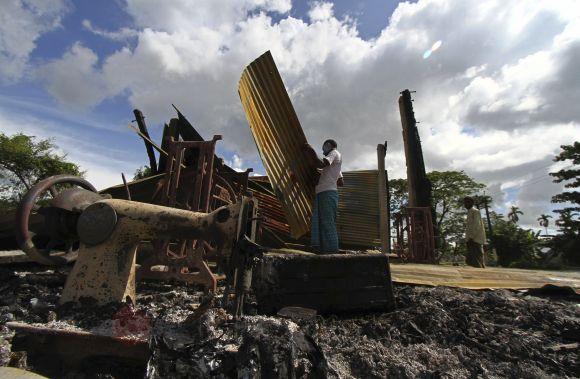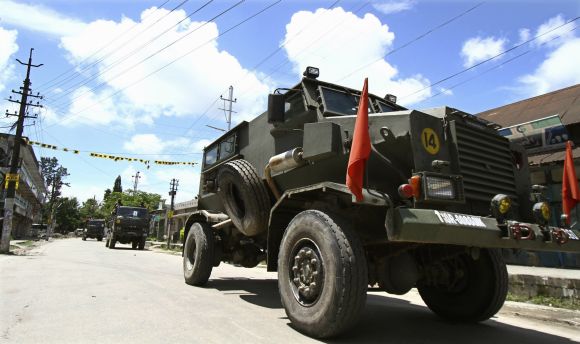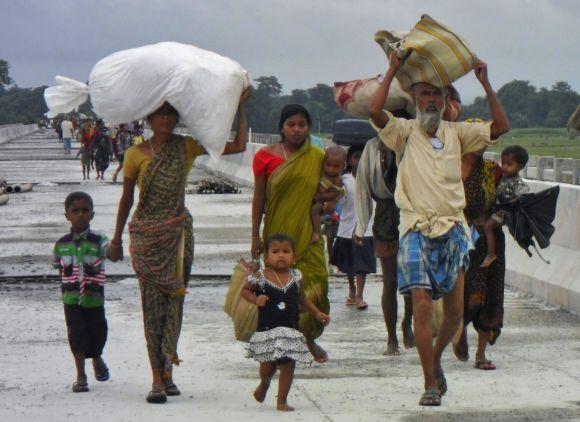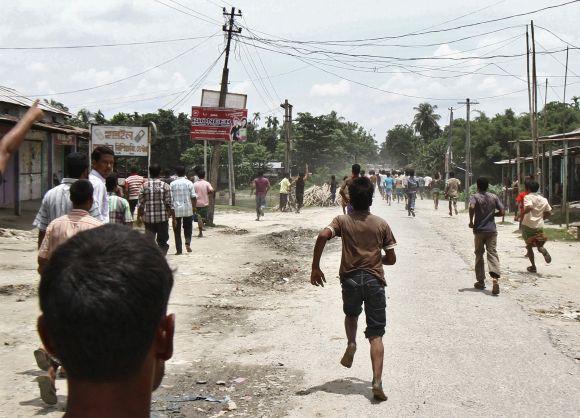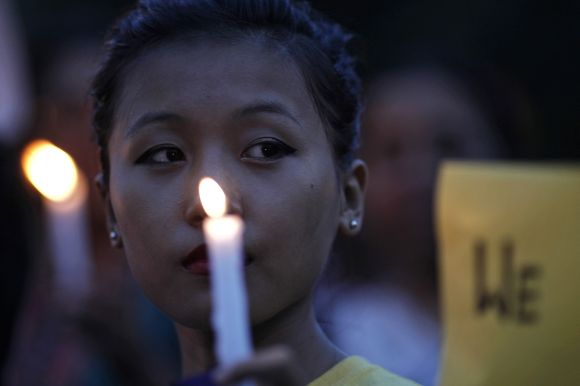 | « Back to article | Print this article |
Criminal dereliction of duty led to Assam riots: Report
Were the Assam riots preventable but not prevented? A detailed report in this regard suggests that the army was not deployed in the riot affected areas which made the situation even more chaotic than what it already was, reports Vicky Nanjappa.
A report by the Asian Centre for Human Rights suggests that the recent riots in Assam were absolutely preventable but not prevented because of the criminal dereliction of duty by officials, starting from the officer-in-charge of Kokrajhar police station to the highest authorities of India's military establishment i.e. secretary to the ministry of defence, chief of the army staff, director general military operations and the commander of the Eastern Command.
Further, Assam government failed to deploy its 27,595 State Armed Police personnel in the riot affected areas. The Assam government did not deploy the central para-military forces at its command and instead waited for the central government to instruct West Bengal and Meghalaya to send para-military forces," stated Suhas Chakma, director of the centre.
"The refusal of the army to be deployed directly led to increased loss of lives, displacement and consequent spread of hatred in the country. Both under the Armed Forces Special Powers Act, 1958 wherein the army operates in aid of civil power and the Sections 130 and 131 of the Criminal Procedure Code, the army is legally bound to obey the orders of the civilian authorities. By the time the army moved in on July 25, about 44 persons were killed and over 200,000 were displaced," he said.
There must be accountability for such criminal dereliction of duty, he added.
Please click NEXT to read further...
'National Commission for Minorities distorting facts'
ACHR's report has been prepared following a visit by its researchers to the affected areas on July 27-282012, followed by further visits on August 11-12 and August 27-29.
The ACHR stated that a number of anti-tribal secular activists and the National Commission for Minorities have been distorting and misinterpreting facts that caused the riots.
The NCM in its report accused the Bodos of engineering the riots by stating that, "The Bodos need to be told firmly that they cannot under any circumstances engineer a mass exodus of non-Bodos. Nor would they ever get statehood this way."
This statement of the NCM is self contradictory, the ACHR pointed out, as the NCM further stated, "Had prompt action been taken after two Muslims were killed on July 6, or after four Bodos were snatched away from the hands of the police and killed by Muslims, this conflict could have been avoided."
"What the NCM failed to highlight is the fact that there was a gap of 14 days between the killing of two Muslims on July 6 and the killing of four Bodo tribals on July 20, and there were no riots during the intervening period. The riots actually started on July 21 following the lynching of four Bodo tribals by a mob belonging to the Muslim community after snatching them from the custody of the Assam Police on July 20. If indeed the riots have started following the killing of four Bodo youths, could the Bodos be accused of engineering a mass exodus?" the ACHR report asked.
The ACHR lamented that a number of secular activists have described the riots as "ethnic cleansing" and the autonomous councils of the tribals as "incentivising ethnic cleansing" when both communities were affected in the riots and each time the riots started and spread because of the abysmal failure of the state to enforce the law. Although Anjan Pandit, officer-in-charge of the Kokrajhar police station and his police patrol party, were witnesses to the lynching of the four Bodo youths after being snatched away from their custody on July 20, no one has been arrested so far, the report said.
The ACHR also said that communal tension has been building up in Assam since the controversial marriage of Congress MLA Rumi Nath to a Muslim in May 2012.
A section of political leaders of the ruling Congress who have been leading the "Oust Tarun Gogoi" campaign exploited the situation to show the chief minister as an incapable administrator after Gogoi inducted his son as a member of the Congress in May. The rising communal tension and the role of infighting within the ruling Congress to start the riots cannot be discounted, the report pointed out.
Please click NEXT to read further...
'More illegal migration in Kokrajhar than in Assam'
Though illegal immigration based on March 26, 1971 as the cutoff date is not the immediate raison d'etre for the recent riots in the Bodoland Territorial Autonomous Districts, Kokrajhar district bore the brunt of migration more than Assam.
Citing census figures, ACHR stated, "During 1951-1961, Kokrajhar had a decadal growth rate of 46.44 against 34.98 in Assam while it increased to 54.28 (in Kokrajhar) against 34.95 (in Assam) during 1961-1971. For the period 1971-1991, the decadal growth rate of population in Kokrajhar district increased to 76.75 per cent against 53.25 per cent in Assam".
Kokrajhar reflects the trend of decadal growth of population of the BTAD:
Irrespective of whether the explosive decadal growth rate in Kokrajhar district was a consequence of migration and/or illegal immigration, its impact was clear: it caused massive land alienation amongst the Bodos in clear violation of the Chapter X of the Assam Land Revenue Regulation, 1886 that prohibits "transfer, exchange, lease, agreement or settlement of any land in any area or areas constituted into belts or blocks" from tribals to the non-tribals in the areas notified as tribal belts and blocks.
The number of non-tribal villages in the tribal belts and blocks has been increasing with impunity.
Please click NEXT to read further...
'No minimum standards for humanitarian assistance'
The ACHR stated that the camp conditions, where over 400,00 displaced persons were sheltered, have been deplorable and the government of India has failed to adopt "Minimum Standards in Humanitarian Response" as provided in the Sphere Guidelines (external link) despite the country having born out of riots in 1947.
In most of the camps, food was not supplied on time and adequate number of utensils was not supplied. There are very few provisions for drinking water and excreta disposal. The inmates are not willing to return due to security concerns.
However, some families, mostly agriculturists whose houses were not burnt down returned home to cultivate their paddy fields. But the returnees have reportedly neither been provided adequate monetary compensation nor security.
Further, the state government has officially closed down two Muslim relief camps namely Failaguri Kembolpur Relief Camp and Kathalguri/Jacobpur Relief Camp, both in Kokrajhar district, to force the inmates to leave the relief camps.
Please click NEXT to read further...
'Assam govt must prosecute all those responsible for the riots'
In its report, the ACHR recommended to the state government of Assam to
- Prohibit public protests carrying dead bodies and prosecute the organisers/violators for wantonly giving provocative speeches with intent to cause riot and promoting enmity between different groups on grounds of religion, race, place of birth, residence, language, etc. and doing acts prejudicial to maintenance of harmony;
- Identify the riot-prone vulnerable areas, increase the number of police stations and set up police station level monitoring committees who shall fortnightly submit reports to the district magistrate about the prevailing situations relating to ethnic tensions for further appropriate action to prevent riots;
- Establish accountability by prosecuting all those responsible for acts of violence in the riots since July 20, 2012;
- Implement Chapter X of the Assam Land Revenue Regulation, 1886 relating to protection of tribal land and take measures to restore the tribal lands encroached by non-tribals in the BTAD and other parts of Assam in violation of the Assam Land Revenue Regulation, 1886;
- Ensure that no non-tribal is rehabilitated in tribal belts and blocks notified under Chapter X of the Assam Land Revenue Regulation, 1886 unless the non-tribals can show proof of residence prior to the notification of the concerned tribal belts and blocks;
- Improve the humanitarian situations in the relief camps including access to adequate shelter, food, utensils, baby food, clothes, health care, water facility, excreta disposal etc;
- Ensure that no relief camp is forcibly closed down and the inmates are not forced to leave the relief camps; and
- Ensure non-discrimination for access to rehabilitation.
Please click NEXT to read further...
'Hold a national consultation on the issue of illegal immigration'
The ACHR also urged the Union ministry of home affairs to:
- Hold a national consultation on the issue of illegal immigration, take effective measures to stop illegal immigration and raise the issue with the government of Bangladesh;
- Ensure rehabilitation of the displaced persons by providing assistance at par with what is being provided to the Sri Lankan Tamil displaced persons by the government of India including Rs 4.95 lakh as housing assistance per family, setting up of trauma centres for the victims of violence and providing of food rations for six months to enable them to prepare for the next harvest season;
- Provide security to those returning to their villages;
- Seize all the illegal arms and review the arms licenses issued in BTAD; and
- Ensure that ceasefire ground rules with the insurgent groups are fully respected.
TOP photo features of the week
Click on MORE to see another set of PHOTO features...
